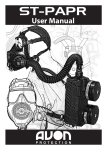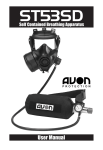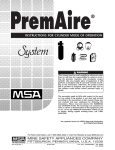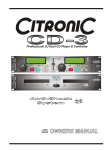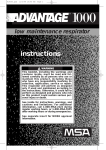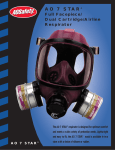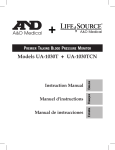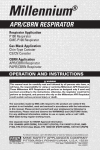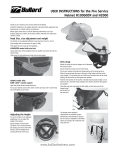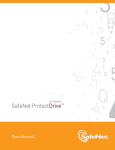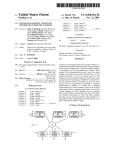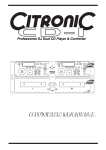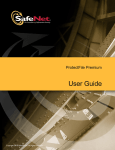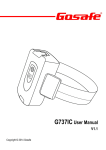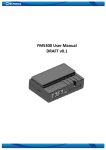Download USER MANUAL - AGT Tactical
Transcript
USER MANUAL Information contained in this manual is technically accurate at the time of this printing. Updates are made periodically to the information herein. If you have comments please forward them to Avon Protection Systems, Inc.. THANK YOU Multi-language versions of this manual available at www.avon-protection.com. AVON FM53 Part number: 72601/59 Issue 2.0 JAN 2010 Table of Contents Section Page 1 Introduction 2 2 FM53 Air Purifying Respirator 3 3 NIOSH Cautions and Limitations 4 4 General Warnings 7 5 Sizing and Fitting Procedures 8 6 Nosecup Sizing and Fitting 9 7 Fitting the Voice Projection Unit (VPU) 10 8 Quantitative Fit Test 11 9 Pre-Check Procedure 12 10 Donning, Negative Pressure and Pre-Use Checks 13 11 Pre-Use Check 18 12 Doffing the Mask (removing) 19 13 Canister Installation and Removal 20 14 Storage and Transportation 21 15 Deployment Stowage 22 16 Head Harness Removal and Installation 23 17 Protective Hood Installation and Removal 24 18 Using the Hydration System 25 19 Vision Correction Assembly Installation and Removal 27 20 Using Outserts 28 21 Twin Port Configuration (if applicable) 29 22 Valve Cassette Assembly Removal and Installation 30 23 Cleaning Procedures 32 24 Maintenance Allocation 33 25 Operator Maintenance 34 26 Level-2 Maintenance 38 27 Operator Troubleshooting Procedures 40 28 Level-2 Maintenance Troubleshooting 42 29 Spare Parts Overview 49 1 2 3 4 5 6 7 8 9 10 11 12 13 14 15 16 17 18 19 20 21 22 23 24 25 26 27 28 29 Introduction Introduction 1 2 3 4 5 6 7 8 9 10 11 12 13 14 15 16 17 18 19 20 21 22 23 24 25 26 27 28 29 2 Congratulations on receiving the most advanced Air Purifying Respirator (APR) in the world. When used in accordance with these instructions, the FM53 Protective Mask will provide the operator with the maximum level of protection, to the face, eyes and respiratory tract from Chemical, Biological, Radiological and Nuclear (CBRN), riot control agents and certain Toxic Industrial Chemicals (TICs). The FM53 is NIOSH approved for use in specific configurations only. These user instructions are arranged into three sections: Section 1: NIOSH APR configurations Section 3: Level I operator and Level II maintenance tasks. There are separate User Instructions for FM53 used with the Avon ISI ST53 SCBA FM53 Air Purifying Respirator The FM53 Protective Mask is also available in a Twinport configuration that allows the canister to be installed on either the left or right (not both) side of the mask. The mask incorporates interchangeable nosecups in 5 sizes: XS extra-small S small M medium L large XL extra-small The major features of the mask are: • The butyl & silicon rubber blended faceblank. This provides an effective seal with increased comfort • optical quality eyelens • Electronic Communications Port (ECP) • Variable Resistance Exhalation Unit (VREU ). The FM53 APR makes use of a Variable Resistance Exhale Unit (VREU). This contains the Exhale Valve Cassette Assembly which allows the mask the operational flexibility to be used in APR (NP Negative Pressure) or SCBA (Positive Pressure) modes . This manual refers to instruction for use of the FM53 in the negative pressure APR mode only. WARNING SPECIAL CARE MUST BE TAKEN TO ENSURE THAT THE VALVE CASSETTE ASSEMBLY WITHIN THE VREU IS SET TO THE CORRECT POSITION FOR THE INTENDED APPLICATION. INCORRECT SETTING WILL VOID THE NIOSH APPROVAL . 1 2 3 4 5 6 7 8 9 10 11 12 13 14 15 16 17 18 19 20 21 22 23 24 25 26 27 28 29 FM53 Air Purifying Respirator The FM53 Protective Mask is available in four sizes with either a left or right filter mount, marked with letters as listed; Extra Small (XS), Small (S), Medium (M), or Large (L). 3 NIOSH Cautions and Limitations NIOSH Cautions and Limitations 1 2 3 4 5 6 7 8 9 10 11 12 13 14 15 16 17 18 19 20 21 22 23 24 25 26 27 28 29 4 S - Special or Critical User’s Instructions When FM53 is used as an APR the VREU Lever must be fully rotated counter-clockwise to the vertical APR position . The FM53 must be stored in the approved Storage Bag and liner except when in operational use or maintained. The Canister must remain sealed until fitted to the respirator prior to use. The Voice Projection Unit (VPU) is a required component for the NIOSH CBRN approved configuration. Industrial APR Cautions and Limitations for Use A Not for use in atmospheres containing less than 19.5 percent oxygen. B Not for use in atmospheres immediately dangerous to life or health. C Do not exceed maximum use concentrations established by regulatory standards . H Follow established cartridge and canister change schedules or observe ESLI to ensure that cartridges and canisters are replaced before breakthrough occurs. J Failure to properly use and maintain this product could result in injury or death. L Follow the manufacturer’s User’s Instructions for changing canisters. M All approved respirators shall be selected, fitted, used, and maintained in accordance with MSHA, OSHA, and other applicable regulations. N Never substitute, modify, add, or omit parts. Use only exact replacement parts in the configuration as specified by the manufacturer. O Refer to User’s Instructions and/or maintenance manuals for information on use and maintenance of these respirators. P NIOSH does not evaluate respirators for use as surgical masks. NIOSH Cautions and Limitations (continued) Special or critical User’s instructions and/or specific limitations apply. Refer to User’s instructions before donning. BB Not for use for entry into atmospheres immediately dangerous to life or health. CC For entry, do not exceed maximum use concentrations established by regulatory standards. FF Respirators to be fit tested prior to use with heaviest cartridges, canisters, filters and/or accessories intended to be used. Fit testing should also be conducted while wearing all personal protective equipment intended to be used. See user’s instructions for fit test requirements . CBRN APR Cautions and Limitations for Use A Not for use in atmospheres containing less than 19.5 percent oxygen. B Not for use in atmospheres immediately dangerous to life or health. C Do not exceed maximum use concentrations established by regulatory standards. H Follow established cartridge and canister schedules or observe ESLI to ensure that cartridges and canisters are replaced before breakthrough occurs. I Contains electrical parts that may cause an ignition in flammable or explosive atmospheres . J Failure to properly use and maintain this product could result in injury or death. L Follow the manufacturer’s User’s Instructions for changing canisters. M All approved respirators shall be selected, fitted, used, and maintained in accordance with MSHA, OSHA, and other applicable regulations. N Never substitute, modify, add or omit parts. Use only exact replacement parts in the configuration as specified by the manufacturer. O Refer to User’s Instructions and/or maintenance manuals for information on use and maintenance of these respirators. P NIOSH does not evaluate respirators for use as surgical masks . R Some CBRN agents may not present immediate effects from exposure, but can result in delayed impairment, illness, or death. S Special or critical User’s Instructions and/or specific use limitations apply. Refer to User’s Instructions before donning. T Direct contact with CBRN agents requires proper handling of the respirator after each use and between multiple entries during the same use. Decontamination and disposal procedures must be followed. If contaminated with liquid chemical warfare agents, dispose of the respirator after decontamination. V Not for use in atmospheres immediately dangerous to life and health or where hazards have not been fully characterized. NIOSH Cautions and Limitations (continued) S 1 2 3 4 5 6 7 8 9 10 11 12 13 14 15 16 17 18 19 20 21 22 23 24 25 26 27 28 29 5 NIOSH Cautions and Limitations (continued) NIOSH Cautions and Limitations (continued) 1 2 3 4 5 6 7 8 9 10 11 12 13 14 15 16 17 18 19 20 21 22 23 24 25 26 27 28 29 6 W Use replacement parts in the configuration as specified by the applicable regulations and guidance. X Consult manufacturer’s User’s Instructions for information on the use, storage, and maintenance of these respirators at various temperatures. Y This respirator provides respiratory protection against inhalation of radiological and nuclear dust particles. Procedures for monitoring radiation exposure and full radiation protection must be followed. Z If during use an unexpected hazard is encountered such as a secondary CBRN device, pockets of entrapped hazard or any unforeseen hazard, immediately leave the area for clean air. CC For entry, do not exceed maximum use concentrations established by regulatory standards. HH When used at defined occupational exposure limits, the rated service time cannot be exceeded. Follow established canister change out schedules. QQ Use in conjunction with personal protective ensembles that provide appropriate levels of protection against dermal hazard. Failure to do so may result in personal injury even when the respirator is properly fitted, used, and maintained. UU The respirator should not be used beyond eight (8) hours after initial exposure to chemical warfare agents to avoid possibility of agent permeation. If liquid exposure is encountered, the respirator should not be used for more than two (2) hours. General Warnings FAILURE TO OBSERVE THESE WARNINGS MAY RESULT IN INJURY OR DEATH! • Only CBRNF12B and CTF12 Canisters are NIOSH approved for use with FM53. • The operator must read and fully understand these operator instructions prior to use. • The operator must have received training in the use of the mask including, but not limited to, pre-use check, donning, seal check, use, doffing (removal), modes of operations and maintenance. • Sizing and fitting procedures must be performed by a trained (Level-2) technician. Operator safety depends on a properly fitted mask. The mask must be sized and adjusted for the individual operator following the procedures given in these instructions. Injury or death can occur if the mask does not properly fit. • It is important to conduct proper care, maintenance and keep the mask clean. An improperly maintained mask may compromise its ability to provide maximum protection. • The mask used in APR mode is not intended for use in enclosed or confined space or oxygen deficient environment. • Do not over-tighten the Canister. Canister should be hand tight. • Always select the correct size of mask for each individual operator. Operators are required to conduct a quantitative fit test to confirm the correct mask size has been selected. • Always don and doff the mask in an area known to be free of contaminants. • Always perform a satisfactory negative pressure check before entering a contaminated area. • Keep a cleanly shaven face to ensure a good seal. Operators shall remove all hairpins, combs, hair knots, buns, or braids that will interfere with the seal of the mask. • Do not use abrasive or solvent cleaners of any sort to clean the mask. • Do not wear contact lenses when wearing the mask. • Specialist maintenance, other than the normal operator checks (Level 1) specified in this manual, must be performed by an Avon certified service center or by Avon certified (Level-2) technician. General Warnings WARNING 1 2 3 4 5 6 7 8 9 10 11 12 13 14 15 16 17 18 19 20 21 22 23 24 25 26 27 28 29 7 Sizing and Fitting Procedures Sizing and Fitting Procedures 1 2 WARNING 3 SIZING AND FITTING PROCEDURES MUST BE PERFORMED BY A 4 TRAINED (LEVEL-2) TECHNICIAN 5 The FM53 Protective Mask is available in four sizes. A sizing tool is available to assist in 6 initial selection of the correct mask size. It does no more than assist initial selection. Only a successful completion of a quantitative fit test can determine correct fit. 7 It is a requirement that the initial sizing and fitting be performed by trained 8 personnel. 9 Correct When sizing is correct the eyes of the operator appear 10 on or slightly above the lens horizontal centre line. A correctly sized mask should make firm contact with 11 the face around the entire length of the face seal. The distance between the edge of the mask and the ear 12 Correct should be typically in the range .5 to 1.5 inches (15mm correct to 25mm). 13 14 If the mask is too small, the operator may lose seal performance and protection. The mask will be 15 Correct uncomfortable to wear and could affect field of view. 16 Too Smalltoo small 17 If the mask is too large the operator may lose seal 18 performance and protection. The operator will also Too Small experience a very loose fit with subsequent mask 19 slippage. 20 too large 21 Sizing Tool (pn:72601/55) 22 offers a sizing tool to aid in the selection of the correct mask size. TooAvon Large Too Small 23 24 25 Too Large 26 Place the tool to the face Read off the appropriate Check eye location. 27 diagonally along a line size. If on or near the from the point of the boundary between two 28 chin to the widest point sizes, select the larger size. of the cheekbone. 29 8 Too Large Nosecup Sizing and Fitting When checking for proper nosecup sizing look through the visor at the top of the nosecup. It should be at the top of the nose. If to low, replace with the next size nosecup. If too high, replace with the next smaller nosecup. Compatible Nosecup Sizes Mask Assembly Size Extra Small Small Medium Large Extra Large Large Medium Small Extra Small Nosecup Removal and Installation: WARNING THESE INSTRUCTIONS ARE TO BE PERFORMED BY A LEVEL-2 TECHNICIAN Removal: • Remove the internal drink tube and microphone assembly. • With one hand grasp the nosecup and gently unseat it from the VREU main body. • Gently pull up and out unseating the nosecup from around the drink/communications assembly. Installation: • Orient the nosecup and align the nosecup drink tube and microphone pass-through with the drink communications port. With one hand support the mask and with the other push firmly downward seating the nosecup around the drink communications port ensuring the communications cutout is flush with the top of the communications port. • Ensure the VREU main body cutout in the nosecup is properly routed around the VREU main body assembly on the interior of the mask. • Install the internal drink tube and microphone assemblies. 1 2 3 4 5 6 7 8 9 10 11 12 13 14 15 16 17 18 19 20 21 22 23 24 25 26 27 28 29 Nosecup Sizing and fitting There are 5 nosecups available extra small, small, medium, large and extra large for proper sizing and operator comfort. 9 Fitting the Voice Projection Unit (VPU) FItting the Voice Projection Unit (VPU) 1 2 3 4 5 6 7 8 9 10 11 12 13 14 15 16 17 18 19 20 21 22 23 24 25 26 27 28 29 10 WARNING THE VPU IS REQUIRED FOR NIOSH CBRN APLLICATIONS. ANY FIT TEST MUST BE UNDERTAKEN WITH THE VPU IN PLACE. The FM53 Protective Mask has a ECP to attach the voice projection unit and other communications devices which use an internal microphone. (pn: 72601/13) To attach the voice projection unit: • Prior to installing the VPU, ensure the VREU Lever is in the Negative Pressure APR Mode. • Bring the voice projection unit to the mask with one hand at approximately 45 degrees to the right. • Locate the mounting groove ,insert the voice projection unit and rotate clockwise ¼ turn. An audible click should be heard and the Voice projection unit will not rotate any further. • Plug the 3-pin connecter into the 3-pin ECP. To remove the voice projection unit: • Support the mask with one hand. Unplug the 3-pin connector from the ECP. • Grasp the voice projection unit with one hand; with the index finger of the same hand, depress the locking lever and rotate the counterclockwise approximately ¼ turn. • Pull away separating the voice projection unit from the mask. Microphone Assembly Installation (pn: 72601/17) • Connect the dynamic microphone to the amplifier adapter by aligning the connecting pins on the adapter with the connector receptacle on the microphone. • Gently press the amplifier adapter into the dynamic microphone. (Ensure the dynamic microphone is oriented as illustrated) • Using a jeweller’s screwdriver, tighten the two retaining screws on the dynamic microphone securing it to the amplifier adapter. • Install the microphone assembly into the mask internal ECP. Quantitative Fit Test FIT TESTING PROCEDURES MUST BE PERFORMED BY A TRAINED (LEVEL-2) TECHNICIAN! Avon recommends that the operator undertake a quantitative fit test to confirm that the correct mask size has been selected and that a good fit can be obtained. • Avon recommends a Fit Factor (FF) of 2500 minimum. • Fit test exercises should be performed in accordance with established protocol. • When using an ambient particle type tester, a background particle count of 10,000 is recommended before testing. Skullcap Brow Strap Cover Brow Strap Temple Strap Cheek Strap Follow this sequence: • Performance of fit testing should be performed without the hood assembly attached. • Remove the internal drink tube. • Don the selected mask size (section 7). • Connect the drink coupler to the sample adapter. • Rotate drink lever upward to the open position. WARNING FOLLOWING INITIAL SIZING AND FITTING DO NOT READJUST THE BROW AND TEMPLE STRAPS. CHEEK AND TEMPLE STRAPS TIGHTNESS MAY REQUIRE ADJUSTING EVERY TIME THE MASK IS DONNED. • Pull the loose end of the harness straps to tighten the harness. Sufficient load must be applied to ensure a tight but comfortable fit. • If necessary alter the length of the brow straps in the brow strap pockets to ensure the temple and cheek straps do not touch the ears. Check that the brow straps are equal length. • Stow drink coupler into it’s receptacle. • Install the internal drink tube. Quantitative Fit Test WARNING 1 2 3 4 5 6 7 8 9 10 11 12 13 14 15 16 17 18 19 20 21 22 23 24 25 26 27 28 29 11 Pre-Check Procedure Pre-Check Procedure 1 2 3 4 5 6 7 8 9 10 11 12 13 14 15 16 17 18 19 20 21 22 23 24 25 26 27 28 29 12 Always perform the following pre-use check procedure before using the FM53 Protective Mask: • Ensure the mask is complete and is the correct size for the particular operator as determined during sizing and fitting. • Check that there are no cuts or tears in the rubber components, no chips or cracks in the plastic components and the eyelens is optically clear. • Check that the brow straps are stowed in the brow strap pockets. Note: Brow and temple straps should be equal length. 8 • Check that the lower two cheek straps are fully slackened prior to donning. • Always check that the mask is fitted with an appropriate canister and ensure that the canister has been correctly attached (hand tight only). Refer to section 13 for proper canister installation. • Check that the Valve Cassette Assembly Lever is set to the vertical position for the APR Negative Pressure Mode. Donning, Negative Pressure and Pre-Use Checks WARNING IMPORTANT: BEFORE DONNING THE MASK FOR THE FIRST TIME THE OPERATOR MUST BE PROPERLY SIZED AND FITTED. SEE SECTION 5! NOTE: Mask must be properly stowed prior to donning. See section 8 for proper procedures. • The voice projection unit must be removed prior to donning the mask. • Remove head gear and glasses if worn. • Pull the head harness over the front of the eyelens. • Pull hair back and insert the chin into the mask. • Grasp the head harness tab and pull the head harness over and to the back of your head. • Pull the harness tightly down at the rear. • Support the mask by locating and placing your hand over the VREU. • Pull the cheek straps one at a time, ensuring straps lay flat against your head. Brow and temple straps are adjusted during fitting. Do not over-tighten. 1 2 3 4 5 6 7 8 9 10 11 12 13 14 15 16 17 18 19 20 21 22 23 24 25 26 27 28 29 Donning, Negative Pressure and Pre-Use Checks Donning without Hood 13 Donning, Negative Pressure and Pre-Use Checks (continued) Donning, Negative Pressure and Pre-Use Checks (continued) 1 2 3 4 5 6 7 8 9 10 11 12 13 14 15 16 17 18 19 20 21 22 23 24 25 26 27 28 29 14 Negative Pressure Check without Hood WARNING DO NOT ENTER A CONTAMINATED AREA UNTIL A SUCCESSFUL NEGATIVE PRESSURE TEST HAS BEEN PERFORMED! Perform a Negative Pressure Test using the following steps • With a hand over the VREU, blow out hard to force out any contaminated air around the edges of the mask. • With palm of hand, cover the canister inlet port and breathe in. • The mask should collapse against your face and remain so while holding your breath. If it does, the mask is airtight. • If the mask does not collapse, check for leaks. If the mask still does not collapse, notify maintenance personnel. Donning, Negative Pressure and Pre-Use Checks (continued) WARNING IMPORTANT: BEFORE DONNING THE MASK FOR THE FIRST TIME THE OPERATOR MUST BE PROPERLY SIZED AND FITTED. SEE SECTION 5! NOTE: Mask must be properly stowed prior to donning. See section 8 for proper stowing procedure. • The voice projection unit must be removed prior to donning the mask. For CBRN applications it must be refitted before use. • Remove head gear and glasses if worn. • Pull hair back and insert the chin into the mask. • Grasp the head harness tab and pull the head harness over and to the back of your head. • Pull the harness tightly down at the rear. • Support the mask by locating and placing your hand over the VREU. • Pull the cheek straps one at a time, ensuring straps lay flat against your head. Brow and temple straps are adjusted during fitting. Do not over-tighten. 1 2 3 4 5 6 7 8 9 10 11 12 13 14 15 16 17 18 19 20 21 22 23 24 25 26 27 28 29 Donning, Negative Pressure and Pre-Use Checks (continued) Donning with Hood 15 Donning, Negative Pressure and Pre-Use Checks (continued) Donning, Negative Pressure and Pre-Use Checks (continued) 1 2 3 4 5 6 7 8 9 10 11 12 13 14 15 16 17 18 19 20 21 22 23 24 25 26 27 28 29 16 Negative Pressure Check with Hood WARNING DO NOT ENTER A CONTAMINATED AREA UNTIL A SUCCESSFUL NEGATIVE PRESSURE TEST HAS BEEN PERFORMED! Perform a Negative Pressure Test using the following steps • With a hand over the VREU, blow out hard to force out any contaminated air around the edges of the mask. Protective Hood removed for clarity • With palm of hand, cover the canister inlet port and breathe in. • The mask should collapse against your face and remain so while holding your breath. If it does, the mask is airtight. • If the mask does not collapse, check for leaks. If the mask still does not collapse, notify maintenance personnel. Protective Hood removed for clarity Donning, Negative Pressure and Pre-Use Checks (continued) • Insert both hands through the opening in the bottom of the hood spreading them apart as far as possible. • Trace the outline of the mask with both hands pushing the protective hood over the head, covering the head, neck and shoulders. • Insert your arms, one at a time, through the holes formed by the underarm straps. • Adjust by pulling on the free running end at the same time. 1 2 3 4 5 6 7 8 9 10 11 12 13 14 15 16 17 18 19 20 21 22 23 24 25 26 27 28 29 Donning, Negative Pressure and Pre-Use Checks (continued) Donning with Hood continued 17 Pre-Use Check Pre-Use Check 1 2 3 4 5 6 7 8 9 10 11 12 13 14 15 16 17 18 19 20 21 22 23 24 25 26 27 28 29 18 This check needs to be carried out with a partner or buddy. • Check that the VREU Lever is set to the correct position. VREU Lever to be set vertically for APR Mode. • For CBRN applications fit the VPU and ensure a new Energizer EL123 or Duracell DL123 battery is installed into the VPU prior to entering a hazardous environment. Doffing the Mask (removing) • When the protective hood is attached, release underarm strap fasteners, grasp the bottom of the protective hood and pull the hood up and over the head. with hood without hood • Slacken the cheek straps to their fullest extent. with hood without hood • Grasp the front of the mask and pull the mask well forward and lift upwards then backwards off the head. 1 2 3 4 5 6 7 8 9 10 11 12 13 14 15 16 17 18 19 20 21 22 23 24 25 26 27 28 29 Doffing the Mask (removing) Doffing the Mask (removing) 19 Canister Installation and Removal WARNING FAILURE TO OBSERVE THESE WARNINGS MAY RESULT IN INJURY OR DEATH! • Only CBRNF12B and CTF12 Canisters are NIOSH approved for use with FM53. • Do not over-tighten the Canister. Canister should be hand tight. Installation: • Ensure the filter mount gasket is attached to the filter mount before installing the Canister. Canister Installation and Removal 1 2 3 4 5 6 7 8 9 10 11 12 13 14 15 16 17 18 19 20 21 22 23 24 25 26 27 28 29 20 • Insert the male threaded portion of the Canister into the filter mount. • Rotate the Canister clockwise until the Canister is hand tight. Removal: Grasp the Canister and turn it counter clockwise until the Canister separates from the filter mount. Storage and Transportation FAILURE TO PROPERLY STORE YOUR MASK COULD RESULT IN THE MASK NOT PROVIDING ADEQUATE PROTECTION WHEN USED NEXT! Faceform (pn: 72601/53) The faceform is used to prevent damage to the mask in storage. It is used for storage periods in excess of 30 days. Safe storage and transportation of the mask is vitally important in maintaining its effectiveness: • Store the mask in the NIOSH approved Storage Bag and Liner. • Store and transport in a clean and dry environment within the guidelines of local established procedures. • Do not store or transport the mask under heavy or sharp objects. • Do not store or transport the mask where it could be exposed to extremes of temperatures or direct sunlight. • Always clean and thoroughly dry the mask before storage. Storage and Transportation WARNING 1 2 3 4 5 6 7 8 9 10 11 12 13 14 15 16 17 18 19 20 21 22 23 24 25 26 27 28 29 21 Deployment Stowage Deployment Stowage 1 2 3 4 5 6 7 8 9 10 11 12 13 14 15 16 17 18 19 20 21 22 23 24 25 26 27 28 29 22 Avon provides a number of carriers for Stowage during deployment. These are not for long term storage. The following are instructions for storage in carriers for use during operations only. • Remove the voice projection unit and store as shown. • It is recommended that the FM53 be stored with outsert attached. • Loosen cheek straps to their fullest extent. Carefully grasp the cheek straps and pull the head harness over the front of the mask. • Open the mask carrier and insert the mask into the carrier with the eyelens towards the top as worn with the mask facing out away from the body as shown. • Close the carrier. Stowage Configuration with Protective Hood • Grasp the mask by the front module and place other hand inside the hood, grasping onto the harness. • Pull the hood over the mask. • Carefully pull all excess hood material over the front of the mask. • Grasp the head harness and fold over the front of the mask. Ensure the straps of the head harness do not interfere with the mask seal. • Hold onto the bottom of the hood and hang the mask upside down with the inside of the mask facing away from the body. • Fasten and place the straps inside the hood. • Fold each of the hood flaps into the center. • Fold the flap towards the outside of the mask and secure under the head harness. Head Harness Removal and Installation THE OPERATOR MUST BE REFITTED EACH TIME THE HEAD HARNESS IS REMOVED. FAILURE TO DO SO COULD RESULT IN FACE SEAL LEAKS! brow straps skullcap Head Harness (pn: 72601/1) temple straps cheek straps Removal: • Open the two brow strap covers at the top of the head skullcap and pull the brow straps through the brow strap slots. • Remove the temple and cheek straps from the buckles. Installation: • With the brow straps facing up, slide the brow straps through the brow straps slots at the top of the mask. • Fold straps back over slots and fasten to the brow strap covers at the top of the head harness skullcap. Ensure that the brow strap is aligned with the edge of the brow strap cover. • Thread the temple and cheek straps through the buckles by pushing the folded end of the strap through the slot closest to the buckle tab. • Loop the strap over the crossbar and push the end into the slot furthest from the buckle tab. • Continue pushing the end of the strap thought the buckle until a short length is exposed. • Grasp the exposed portion and pull the rest of the folded end through the slot. Ensure that the straps are fully slackened to allow a proper fitting. Head Harness Removal and Installation WARNING 1 2 3 4 5 6 7 8 9 10 11 12 13 14 15 16 17 18 19 20 21 22 23 24 25 26 27 28 29 23 Protective Hood Installation and Removal Protective Hood Installation and Removal 1 2 3 4 5 6 7 8 9 10 11 12 13 14 15 16 17 18 19 20 21 22 23 24 25 26 27 28 29 24 • Remove the canister and voice projection unit. • Place the protective hood on a flat surface with hood mask openings facing up. • Insert the mask into the hood from the bottom with the mask facing up and aligned with the hood cutouts. • Remove the drink coupler from it’s receptacle and unstow the external drink tube. • Route the drink coupler and external drink tube through the communications port cutout of the hood. • Unfasten the hook and pile straps on the hood and feed through the hood attachment slots on the mask. Refasten the strap. • Adjust the hood so that the rubber portion Hood Attachment Slot surrounds the VREU main body, communications port and the filter mount. • Stow the drink coupler in the receptacle on the mask and ensure the external drink tube is properly stowed around the VREU main body. • Replace the canister and voice projection unit. • Return mask to stowage configuration. WARNING ENSURE THE RUBBER PORTION OF THE HOOD DOES NOT INTERFERE WITH THE MOUNTING OF THE CANISTER! Hood Assembly Inspection Verify the following: • The hood edges are behind the outsert receptacles. • There are no gaps or skin showing anywhere around the head. • The rubber portion of the hood is positioned correctly on the mask. Using the Hydration System USE ONLY APPROVED HYDRATION ATTACHMENTS OR ADAPTERS WITH THE FM53 HYDRATION SYSTEM. FAILURE TO OBSERVE THIS WARNING MAY RESULT IN INJURY OR DEATH! THE USE OF THE HYDRATION SYSTEM WITHIN A CONTAMINATED AREA IS NOT PERMISSIBLE BY NIOSH. Connecting the Hydration System • While steadying the mask assembly with one hand, pull the drink coupler from its storage location. • Flip open the protective cover on the approved hydration system. • Insert the drink coupler into the approved hydrations system by pushing quickly so the seal snaps into the receiving groove. • Turn the drinking tube lever upward and grasp the internal drink tube between your lips. Check for leaks by blowing into the internal drink tube. You should feel some resistance; if not, then your hydration system is leaking, DO NOT drink. Replace the hydration system. If resistance is still not felt, notify maintenance personnel to replace the mask. • If the system does not leak, you may drink. DO NOT tilt head back while drinking. • When finished drinking: Blow into the internal drink tube. Rotate the drink tube lever down to the closed position. When using an approved hydration system, if applicable, ensure it’s on/off valve is also closed. Using the Hydration System WARNING 1 2 3 4 5 6 7 8 9 10 11 12 13 14 15 16 17 18 19 20 21 22 23 24 25 26 27 28 29 25 Using the Hydration System (continued) Using the Hydration System (continued) 1 2 3 4 5 6 7 8 9 10 11 12 13 14 15 16 17 18 19 20 21 22 23 24 25 26 27 28 29 26 WARNING TO PREVENT POSSIBLE LEAKAGE AROUND THE MASK, DO NOT PULL ON EXTERNAL DRINK TUBE WHEN REMOVING DRINK COUPLER. WHEN NOT IN USE, KEEP THE DRINK COUPLER COVERED WITH THE PROVIDED PROTECTIVE COVER! Disconnecting the Hydration System • Rotate the drink tube lever upward to the open position. If using an approved drink system, if applicable open it’s on/off valve. • Clear water from the external drink tube by blowing into the internal drink tube. • Rotate the drink lever downward to the closed position. If using an approved drink system, if applicable close it’s on/off valve. • While holding the drink system with one hand, firmly grasp the drink coupler and pull to disconnect from the hydration system. • If equipped, replace protective cover on the hydration system. • Replace the drink coupler into the drink coupler receptacle. Vision Correction Assembly Installation and Removal Mounting Frame Adjusting Column Frame Tabs Mounting Frame Vision Correction Assembly (pn: 70501/155) Complete vision correction assembly with prescription lens is available from Avon; See the order from at the end of these User Instructions. Note: A valid prescription (within 1 year) is required. When the vision correction system has been received, fit it to the mask as follows: • Fit the frame tabs into the sockets either side of the lens and fit the central stud in the center of the top edge of the mask lens. • Ensure the frame is positioned around the border of the lens. • Adjust the height of the mounting frame using the adjuster. 1 2 3 4 5 6 7 8 9 10 11 12 13 14 15 16 17 18 19 20 21 22 23 24 25 26 27 28 29 Vision Correction Assembly Installation and Removal Optical Insert Mounting Frame Slot 27 Using Outserts Using Outserts 1 2 3 4 5 6 7 8 9 10 11 12 13 14 15 16 17 18 19 20 21 22 23 24 25 26 27 28 29 28 Outserts A variety of outserts are available to meet operational requirements. • Clear Outsert Assembly for general use. • Sunlight Outsert Assembly for high UV situations. • Blueblocker Outsert Assembly for shooting glare. Clear Outsert • Laser outsert assembly (NOT NIOSH APPROVED) for protection from laser energy. Installation and removal: To Install: • Grasp the top and bottom of the outsert with both hands. • Tilt the outsert with the bottom up and align outsert over the eyelens. Outsert receptacle • Align the locking tabs on the ends of the outsert with outsert receptacles on the mask and gently rotate the outsert down pushing the locking tabs into the receptacles. • Ensure the locking tabs are secured to the mask assembly. To remove: grasp the top and bottom of the outsert and gently rotate the bottom of the outsert up and away from the mask. WARNING ENSURE THAT IF REMOVING OUTSERTS IN AN CONTAMINATED ENVIRONMENT THAT YOU HOLD THE MASK AGAINST YOUR FACE WITH YOUR FREE HAND TO ENSURE THE SEAL OF THE MASK IS NOT BROKEN! Twin Port Configuration (if applicable) THIS PROCEDURE MUST BE PERFORMED BY LEVEL-2 TRAINED PERSONNEL ONLY! FAILURE TO FOLLOW THE PROCEDURE CORRECTLY AND AFTERWARDS CHECK THE MASK FOR LEAKAGE COULD RESULT IN THE MASK PROVIDING LOW PROTECTION WHICH MAY LEAD TO INJURY OR DEATH. Special Tool: Filter Mount Plug Tool P/N 72601/57 Filter Mount Blanking Plug P/N 72601/56 Required for configuring the canister port Left/Right on the twin port mask. • Remove the canister • Firmly grip the filter mount containing the plug with one hand. • Using the filter mount plug tool, unscrew the plug counterclockwise and remove from the filter mount. • Examine the filter mount gasket and replace if damaged. • Insert plug into opposite filter mount and screw in clockwise until hand tight. • Firmly grip the filter mount with one hand and using the tool, tighten the plug with as much force as the tool will allow. Starting from hand tight, the plug should turn through at least 1/5 of a rotation. • Examine the interior of the mask and check that the air deflectors and inlet disk valves are installed correctly in both filter mounts. Adjust or replace if necessary (section 20). • Perform a negative pressure test on the mask in accordance with established procedures. • Replace the canister prior to use. Twin Port Configuration (if applicable) WARNING 1 2 3 4 5 6 7 8 9 10 11 12 13 14 15 16 17 18 19 20 21 22 23 24 25 26 27 28 29 29 Valve Cassette Assembly Removal and Installation Valve Cassette Assembly Removal and Installation 1 2 3 4 5 6 7 8 9 10 11 12 13 14 15 16 17 18 19 20 21 22 23 24 25 26 27 28 29 30 WARNING THIS PROCEDURE MUST BE PERFORMED BY LEVEL-2 TRAINED PERSONNEL ONLY! FAILURE TO FOLLOW THE PROCEDURE CORRECTLY AND AFTERWARDS CHECK THE MASK FOR LEAKAGE COULD RESULT IN THE MASK PROVIDING LOW PROTECTION WHICH MAY LEAD TO INJURY OR DEATH. CAUTION REMOVE THE VREU LEVER FROM THE VALVE CASSETTE ASSEMBLY PRIOR TO REMOVING THE VALVE CASSETTE ASSEMBLY FROM THE VREU BODY. DAMAGE TO THE VALVE CASSETTE ASSEMBLY MAY OCCUR. CAUTION ENSURE THE REMOVAL TOOL IS CORRECTLY INSTALLED. DAMAGE TO THE VALVE CASSETTE ASSEMBLY MAY OCCUR. Special Tool: Valve Cassette Assembly Removal Tool P/N 72601/7 Valve Cassette Assembly P/N 72601/6 Removal: • Remove the VREU Lever by gently pulling upwards from behind the thumb pad area of the lever using caution to not break the lever, until the snaps are released from the Valve Cassette Assembly Cover. • Align the removal tool notches with the corresponding (size) notches on the valve cassette assembly taking care to fit the removal tool notch around the VREU Lever. • Depress the removal tool latch disengaging the retaining clip and rotate the valve cassette assembly counter clockwise until it disengages from the main body. NOTE: The valve cassette assembly can remain tight after disengagement; this may require additional manipulation to unseat from the VREU main body. Valve Cassette Assembly Removal and Installation (continued) the VREU main body, locate the o-rings. • The first o-ring is removed by rolling it off the end of the assembly. • To remove the second o-ring, insert an appropriate sized screwdriver under the o-ring and gently pry up from the valve cassette assembly. • Slide the second o-ring off the end of the valve cassette assembly. WARNING REPLACE THE O-RINGS EVERY TIME THE VALVE CASSETTE ASSEMBLY IS REMOVED FROM THE VREU MAIN BODY. FAILURE TO DO SO MAY CAUSE EXCESSIVE WEAR ULTIMATELY CAUSING LEAKS. Installation: • Support the valve cassette assembly with one hand, with the other, roll the o-ring onto the assembly from the end of the positive pressure valve. • Roll the o-ring into the channel in the valve cassette assembly main body, ensuring it is not distorted in any way. • While supporting the valve cassette assembly with one hand, install the second o-ring in the channel closest to the positive pressure valve ensuring it is not distorted. • Orient the valve cassette assembly tabs with the corresponding notches on the main body. • Insert the removal tool into the corresponding notches on the valve cassette assembly. • Rotate the tool clockwise until the valve cassette assembly latch is fully seated. • Reattach the VREU Lever by snapping it into the Valve Cassette Assembly. Valve Cassette Assembly Removal and Installation (continued) • With the valve cassette assembly removed from 1 2 3 4 5 6 7 8 9 10 11 12 13 14 15 16 17 18 19 20 21 22 23 24 25 26 27 28 29 31 Cleaning Procedures Cleaning Procedures 1 2 3 4 5 6 7 8 9 10 11 12 13 14 15 16 17 18 19 20 21 22 23 24 25 26 27 28 29 32 Cleaning the mask correctly is vital for maintaining its effectiveness in providing the best possible protection. The mask should be cleaned regularly as part of the normal maintenance and inspected routinely after each use. Follow this procedure: • Remove the Canister. (If the Canister becomes water logged then it must be replaced immediately. A Canister becomes ineffective if immersed in, or heavily soaked with water.) • Remove the communications lead, microphone assembly and voice projection unit, if attached. • Remove the protective hood if attached. • Remove the drink coupler from its housing and from around the VREU main body. • Remove the air deflector and inlet disk valve. • Immerse the mask in warm water containing a dilute Hibitane solution (1/2000 dilution of a 5% solution is normal), a mild baby-type non-allergic soap solution or other Avon approved product. WARNING • DO NOT USE DETERGENT, SPIRIT OR SOLVENT CLEANER! 8 Agitate the mask in this solution, wiping with a soft, lint-free cloth (face cloth) particularly under the main seal and inner mask. • Remove the mask and shake off the excess solution. • Immerse the mask in clean warm water ensuring that all trace of solution is removed. • Lift out the mask and shake off excess water, then dry with clean, lint-free dry cloth, or air dry. • To clean the hydration system, fill a canteen with a sterilizing solution and attach to the drink coupler. Open drink valve and allow solution to run through and out of the internal drink tube. Repeat with clean water. • Replace the inlet disk valve(s) and air deflectors, ensuring they are properly aligned. • Replace the mask components and store ready for use. WARNING IF THE MASK IS EXPOSED TO CHEMICAL WARFARE AGENTS, SPECIAL DECONTAMINATION AND DISPOSAL PROCEDURES DICTATED BY LOCAL ESTABLISHED GUIDELINES MUST BE FOLLOWED. IF THE MASK IS CONTAMINATED WITH LIQUID CHEMICAL WARFARE AGENTS, DISPOSE OF THE MASK AFTER DECONTAMINATION! Maintenance Allocation There are two levels of maintenance for the FM53 Protective Mask: Level 1: No tools or speciality training required to perform maintenance operation as covered in the FM53 Protective Mask Operator Manual. Level-2: Special tools and training required as covered in this manual. The following Level 1 mask maintenance should be performed by the operator: • General inspection and cleaning. • Removal and replacement of the filter gasket. • Removal and replacement of the air deflector. • Removal and replacement of the inlet disk valve. • Removal and replacement of the head harness. • Removal and replacement of the outserts. • Removal and replacement of the canisters. • Removal and replacement of the internal drink tube. • Removal and replacement of the microphone assembly. • Removal and replacement of the voice projection unit. • Removal and replacement of the external drink tube and drink coupler assembly. • Removal and replacement of the hood assembly. The following Level-2 maintenance requires speciality training and tools as described in this manual. • Removal and installation of the nosecup. • Removal and installation of the valve cassette assembly using the valve cassette removal tool. • Removal and installation of filter mount plug using the filter mount plug tool on twinport models. 1 2 3 4 5 6 7 8 9 10 11 12 13 14 15 16 17 18 19 20 21 22 23 24 25 26 27 28 29 Maintenance Allocation To maintain maximum performance and protection for the user, the FM53 Protective Mask must be properly maintained. 33 Operator Maintenance Operator Maintenance 1 2 3 4 5 6 7 8 9 10 11 12 13 14 15 16 17 18 19 20 21 22 23 24 25 26 27 28 29 34 Carry out the following care and maintenance checklist after each use and at least monthly. Inspect the following features: Mask Assembly • Dirty enough to affect mask seal or proper function • Rubber is sticky or has holes, tears, or soft sticky spots which allow air to enter • Buckles damaged or missing • Bonding around eyelens not secure Valve Cassette Assembly • Missing • Cracked or chipped • Dirty • Front cover will not turn Canister(s) • Canister does not attach properly • Filter mount gasket missing • Cracked or damaged • Air intake clogged with dirt • Filter mount and/or canister damaged • Dust falls out when filter is shaken (General Purpose Filter Only) Operator Maintenance (continued) Head Harness • Will not hold mask firmly against face • Cut, torn or frayed • Missing tabs • Deteriorated Eyelens • Unable to see well through the eyelens • Eyelens is cracked or cut Voice Projection Unit • Will not fit correctly • Latch broken • Dirty or damaged • 3-pin connector will not plug into ECP • On/off lever will not rotate • Battery expended Outsert • Unable to see well through the outsert • Outsert is cracked or cut 1 2 3 4 5 6 7 8 9 10 11 12 13 14 15 16 17 18 19 20 21 22 23 24 25 26 27 28 29 Operator Maintenance (continued) Carry out the following care and maintenance checklist after each use and at least monthly: 35 Operator Maintenance (continued) Operator Maintenance (continued) 1 2 3 4 5 6 7 8 9 10 11 12 13 14 15 16 17 18 19 20 21 22 23 24 25 26 27 28 29 36 Carry out the following care and maintenance checklist after each use and at least monthly: Air Deflector • Missing • Improper orientation • Dirty or Damaged Air Deflector Removal: Proper alignment of Air Deflector • Fold the nosecup back to expose the air deflector. • Grasp the air deflector and pull outward until it separates from the filter mount. Air Deflector Installation: • Fold the nosecup back to expose the filter mount. • Orient the air deflector tab with the bottom filter mount notch and gently push until the air deflector fully seats into the filter mount. Inlet Disk Valve • Missing • Sticky • Torn • Dirty • Will not seat properly Air deflector and nosecup removed for clarity Inlet Disk Valve Removal: • Fold back the nosecup to expose the air deflector. • Remove the air deflector exposing the inlet disk valve. • Pinch the center of the inlet disk valve between the thumb and index finger and gently pull the disk valve away from the valve mounting post. Inlet Disk Valve Installation: • Fold back the nosecup to expose the filter mount assembly. • Insert the tab on the inlet disk valve into the hole in the valve seat. • From the exterior of the valve seat grasp the tab and gently pull until the disk valve seats into the valve seat. • Replace the air deflector. Operator Maintenance (continued) wearing mask Drink Tube Lever • Missing • Sticking • Will not turn Internal Drink Tube Removal: • Note the internal drink tube position before removal. This will assist in installation. • Grasp internal drink tube at drink tube connector and gently pull internal drink tube from connector. Internal Drink Tube Installation: • Turn the drink tube lever upward to position the internal drink tube for drinking. • Install the internal drink tube on the internal drink tube connector and press internal drink tube in place. Make sure the internal drink tube bottoms fully against the drink tube connector. • Turn the internal drink tube lever downward to place the drink tube in the stowed position. • Verify alignment of the internal drink tube and make adjustments as required. Gasket Removal: • Remove the canister. • With one finger, using your finger nail, pry the gasket from the filter mount. • Gently lift up and out. Gasket Installation: • Hold the gasket between the index finger and thumb and insert into the filter mount. • Ensure the gasket is fully seated in the bottom of the filter mount. Operator Maintenance (continued) Internal Drink Tube • Dirty or Damaged • Leaks • Unable to drink while 1 2 3 4 5 6 7 8 9 10 11 12 13 14 15 16 17 18 19 20 21 22 23 24 25 26 27 28 29 37 Level-2 Maintenance Level-2 Maintenance 1 2 3 4 5 6 7 8 9 10 11 12 13 14 15 16 17 18 19 20 21 22 23 24 25 26 27 28 29 38 WARNING THE FOLLOWING PROCEDURES MUST BE PERFORMED BY LEVEL-2 TRAINED PERSONNEL ONLY! External Drink Tube and Drink Coupler Assembly • Dirty or Damaged • Leaks • Unable to drink while wearing mask External Drink Tube and Drink Coupler Assembly Removal: Note: During disassembly, make a note of the drink coupler orientation, it will assist in the reinstallation. • Lay the mask on a flat surface with eyelens facing up. • Remove the external drink tube and drink coupler from their stowage location. • Firmly grasp the external drink tube near where it connects to the drink/communications port and pull gently until it disconnects from the port. External Drink Tube and Drink Coupler Assembly Installation: • Lay the mask on a flat surface with eyelens facing up. • Insert the drink coupler into it’s storage receptacle and route the external drink tube around the VREU main body as if storing. • Grasp the external drink tube near the drink tube connector aligning it with the drink tube port on the drink/communications port and push inward until the tube fully seats. • Rotating the tube back and forth or lubricating the tube connector with water may assist with installation. Level-2 Maintenance (Continued) • Dirty or Damaged • Leaks • Unable to drink while wearing mask Drink Coupler Assembly Removal: Note: During disassembly, make a note of the drink coupler orientation, it will assist in the reinstallation. • Lay the mask on a flat surface with eyelens facing up. • Remove the external drink tube and drink coupler from their stowage location. • With one had, firmly grasp the drink coupler where it connects to the external drink tube and with the other hand, grasp the external drink tube. • Pull gently in opposite directions until the drink coupler separates from the external drink tube. Drink Coupler Assembly Installation: • Lay the mask on a flat surface with eyelens facing up. • Insert the tube connector of the drink coupler into one end of the external drink tube. Ensure the tube connector seats a minimum of 1/4 inches to the connector. Lubricating the drink coupler tube connector with water may assist with installation. Level-2 Maintenance (continued) Drink Coupler Assembly 1 2 3 4 5 6 7 8 9 10 11 12 13 14 15 16 17 18 19 20 21 22 23 24 25 26 27 28 29 39 Operator Troubleshooting Procedures Operator Troubleshooting Procedures 1 2 3 4 5 6 7 8 9 10 11 12 13 14 15 16 17 18 19 20 21 22 23 24 25 26 27 28 29 40 Symptom/Fault High Inhalation Breathing Resistance High Exhalation Breathing Resistance Low Drinking Rate Probably Cause Action Inlet disk valve sticking. Clean inlet disk valve Blockage in airflow. Check inlet air passages for obstructions and remove. canister is saturated/ clogged. Replace canister Valve cassette assembly in the incorrect operating mode. Ensure the valve cassette assembly is in the negative pressure mode. Valve cassette assembly sticking. Clean the valve cassette assembly. Blockage in airflow. Check exhalation passage for obstruction and remove. Improper function of valve cassette assembly. Report to Level-2 maintenance personnel Water level low hydration system. Refill the reservoir. Drink coupler not fully engaged. Full engage the drink coupler. Drink lever not fully open. Turn drink lever on fully. Blockage in system. Clean hydration system. Operator Troubleshooting Procedures (continued) Suspected Leak (mask fails to seal) Poor light Transmission Through Eyelens Voice Projection Unit Inoperative Probably Cause Action Damage to mask assembly. Examine mask for damage; report to Level-2 maintenance personnel. Canister not completely installed. Check and retighten canister. Mask incorrectly sized or fitted. Report to Level-2 maintenance personnel. Incorrect harness adjustment. Check harness adjustment and readjust if necessary. Dirty eyelens and/or outsert. Clean eyelens and/or outsert. Damaged eyelens and/or outsert. Report to Level-2 maintenance personnel. Microphone adapter missing or damaged. Report to Level-2 maintenance personnel. Voice Projection Unit is missing or damaged. Report to Level-2 maintenace personnel. Battery missing or damaged. Report to Level-2 maintenance personnel. On/off switch in the off position. Switch on/off switch to the on position. Operator Troubleshooting Procedures (continued) Symptom/Fault 1 2 3 4 5 6 7 8 9 10 11 12 13 14 15 16 17 18 19 20 21 22 23 24 25 26 27 28 29 41 Level-2 Maintenance Troubleshooting Level-2 Maintenance Troubleshooting 1 2 3 4 5 6 7 8 9 10 11 12 13 14 15 16 17 18 19 20 21 22 23 24 25 26 27 28 29 42 WARNING THE FOLLOWING PROCEDURES MUST BE PERFORMED BY LEVEL-2 TRAINED PERSONNEL ONLY! 1. Perform function test first. Next, use the symptom index for quick access to the troubleshooting procedures. 2. The following illustration describes the use of the troubleshooting procedures. INPUT Require action perform in the sequence indicated Indicates equipment was not as specified NO Repair procedures ACTION Perform these procedures and repeat the test as indicated to ensure trouble is corrected DECISION Equipment indication Indicates equipment was as specified YES ACTION Required action Level-2 Maintenance Troubleshooting (continued) Eyelens fogs excessively NO Is nosecup damaged? YES Replace nosecup NO Is nosecup properly seated? YES Re-seat and retest Check air deflector NO Is the air deflector missing, damaged or installed incorrectly? Check inlet disk valve NO Replace mask is the inlet disk valve missing, damaged or installed incorrectly? YES Replace the air deflector and retest YES Replace the inlet disk valve and retest Level-2 Maintenance Troubleshooting (continued) EYELENS FOGS EXCESSIVELY 1 2 3 4 5 6 7 8 9 10 11 12 13 14 15 16 17 18 19 20 21 22 23 24 25 26 27 28 29 43 Level-2 Maintenance Troubleshooting (continued) Level-2 Maintenance Troubleshooting (continued) 1 2 3 4 5 6 7 8 9 10 11 12 13 14 15 16 17 18 19 20 21 22 23 24 25 26 27 28 29 44 INSUFFICIENT AIR TO USER Insufficient air to user NO Is the canister clogged? Replace canister and retest Remove the canister, check the filter mount assembly NO Is the filter mount damaged? NO Is it installed correctly and not blocked? YES Replace mask Check air deflector YES Check inlet disk valve Replace air deflector or remove blockage and retest NO Replace mask Is it sticky or improperly installed? YES YES Replace the inlet disk valve and retest Level-2 Maintenance Troubleshooting (continued) Mask fails to seal is the mask properly sized and fitted? NO YES Check mask for holes or tears Refit mask and retest Does the mask have holes or tears NO YES Replace mask NO Is the canister loose or damaged? Is the gasket missing or damaged? Is valve cassette assembly clean? Replace canister or tighten and retest YES Replace gasket and retest NO NO YES Is valve cassette assembly loose or damaged? YES Tighten and/or replace the cassette and retest YES NO Is the VREU seat clean? Clean or replace the cassette and retest NO Clean and retest YES Conduct mask leakage test using a porta count, if available or replace the mask Level-2 Maintenance Troubleshooting (continued) MASK FAILS TO SEAL 1 2 3 4 5 6 7 8 9 10 11 12 13 14 15 16 17 18 19 20 21 22 23 24 25 26 27 28 29 45 Level-2 Maintenance Troubleshooting (continued) Level-2 Maintenance Troubleshooting (continued) 1 2 3 4 5 6 7 8 9 10 11 12 13 14 15 16 17 18 19 20 21 22 23 24 25 26 27 28 29 46 VOICE PROJECTION UNIT INOPERATIVE Voice projection unit inoperative Check communications port contacts on the mask for damage NO NO Replace battery and retest NO Replace mask Is battery missing, damaged or expended? NO Is voice projection unit damaged? Are contacts damaged? YES Replace mask YES Is microphone adapter missing or damaged? YES Replace voice projection unit and retest YES Replace or install microphone adapter and retest Level-2 Maintenance Troubleshooting (continued) Drink system inoperative Is internal drink tube missing or damaged? NO Is external drink tube assembly missing or damaged? NO NO Is drink tube lever damaged? YES Replace the internal drink tube and retest YES Replace the external drink tube assembly and retest YES Replace mask Is drink coupler damaged? NO Is resistance felt when blowing through internal drink tube? NO Replace the drink coupler and retest YES Replace the drink coupler and retest YES NO Is coupler seated properly into canteen cap? Re-seat and retest Is drink system operational? YES Replace mask NO Conduct drink tube leakage test using porta count if available or replace mask Level-2 Maintenance Troubleshooting (continued) DRINK SYSTEM INOPERATIVE 1 2 3 4 5 6 7 8 9 10 11 12 13 14 15 16 17 18 19 20 21 22 23 24 25 26 27 28 29 47 Level-2 Maintenance Troubleshooting (continued) Level-2 Maintenance Troubleshooting (continued) 1 2 3 4 5 6 7 8 9 10 11 12 13 14 15 16 17 18 19 20 21 22 23 24 25 26 27 28 29 48 MICROPHONE ASSEMBLY AND RADIO FREQUENCY CABLE INOPERATIVE Microphone assembly and cable inoperative Is communication system operating? NO Repair communication system and retest YES Check communications port contacts on mask for damage NO Are contacts damaged? Replace mask Check microphone assembly NO Is cable damaged? Check Microphone with assembly NO Is microphone assembly missing, damaged, or improperly installed? Is microphone operational? YES Replace microphone cable and retest YES Replace or re-seat the microphone assembly Replace Microphone assembly and retest NO Replace mask YES Spare Parts Overview External Drink Tube and Drink Coupler Assembly O-rings Valve Cassette Assembly Gasket Internal Drink Tube Nosecup Air Deflector Inlet Disk Valve Head Harness Spare Parts Overview Mask Assembly 1 2 3 4 5 6 7 8 9 10 11 12 13 14 15 16 17 18 19 20 21 22 23 24 25 26 27 28 29 49 Avon 50 & 53 Series Respirator - Vision Correction System Prescription Lens Order Form 1 2 3 4 5 6 7 8 9 10 11 12 13 14 15 16 17 18 19 20 21 22 23 24 25 26 27 28 29 50 Avon 50 & 53 Series Respirator - Vision Correction System Prescription Lens Order Form FAX or mail completed form to Avon Date Daytime Telephone Customer (Shipping Address) Billing Address (if different) Name Name Address Address City City State Zip Code Country State Zip Code Country Email Address Prescription - Please enclose the original or photocopy of the prescription you received from your Optometrist or Ophthalmologist. MUST INCLUDE SPECIFIC PUPIL DISTANCES (PD) IN ADDITION TO PRESCRIPTIONS The ophthalmic laboratory will ship directly to you the corrective lenses mounted in the lens frame system to the billing or shipping address listed above. Please provide the following contact information about your Optometrist or Ophthalmologist if the laboratory has any questions about the prescription: Name Email Telephone Number FAX number Polycarbonate Lens Type (check one) Single Vision St 28 Bifocal (segment heights are 5mm below center unless otherwise noted) OD Add ____________ OS Add ____________ Note: Prescription limits are -10.00 diopters to +8.00 diopters; astigmatic power up to 2.50 diopters Pricing Information (Quantity pricing available) Lens Frame System Lens Type - Single Vision St 28 Bifocal Shipping within the USA already included Total Order Amount: Avon Protection Systems, Inc. 1369 Brass Mill Rd. Suite A Belcamp, MD. 21017 70501/276, Rev. B 4/04/09 $35/system $99/set $139/set International shipping add $20 Send Check or Money order or fill in your credit card information below: Credit Card Information Name as it appears on card: Credit Card Number: Expiration Date: Security Code: Last 3 digits on back of card Office 888-286-6440 FAX 410 273 0126 Email [email protected] www.avon-protection.com *72601/59* Avon Protection Systems Inc 503 Eighth Street Cadillac Michigan 49601 USA Avon Protection Hampton Park West Melksham Wiltshire SN12 6NB UK Telephone: 1 888 AVON 440 Fax: 1 231 889 6202 Telephone: +44 (0) 1225 896705 Fax: +44 (0) 1225 896301 www.avon-protection.com pn:72601/59 Issue:2.0





















































